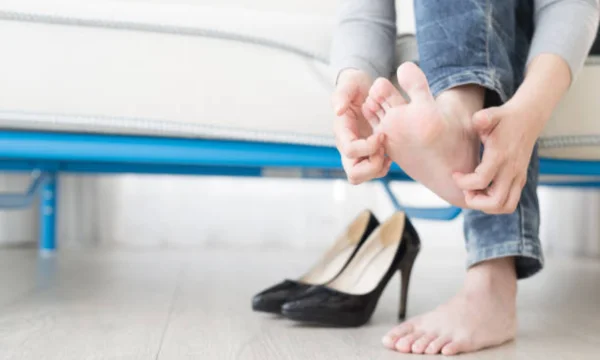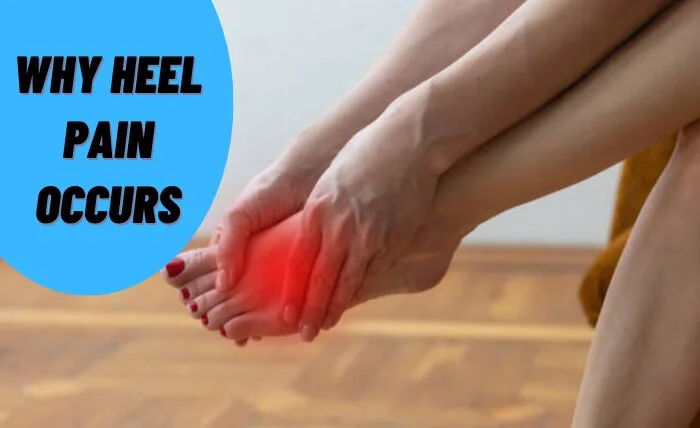Heel pain, a common discomfort many face, often leaves us wondering, Why does this happen? Whether you’re an active runner, a busy professional on your feet all day, or someone noticing unexpected aches, the root causes are crucial. This guide dives into the myriad reasons behind heel pain, from overuse injuries like plantar fasciitis to structural issues such as heel spurs.
With clear, concise insights, we’ll explore not just the why but also how to find relief and prevent future pain. Get ready to step into a world of comfort and knowledge, where every step feels better than the last.
Why Heel Pain Occurs: A Comprehensive Guide
Heel pain stops many in their tracks. It’s more than a nuisance; it affects walks, runs, and even standing. Let’s break down why it happens and how to fix it.
Common Causes of Heel Pain
- Plantar Fasciitis The Leading Cause: This condition strikes when the plantar fascia, the foot’s support, gets inflamed. Sharp pain in your heel as you step out of bed is a tell-tale sign. It’s common in runners and those who are overweight. To treat it, rest and ice your foot. Stretching exercises and supportive shoes help too.
- Achilles Tendinitis Stress on the Achilles Tendon: This issue comes from overuse. The Achilles tendon, linking calf to heel, gets irritated. If you feel pain along the back of your foot, you might have it. It’s seen in active people and the middle-aged. Rest, ice, and gentle stretches work well. So do shoes that give good heel support.
- Heel Spurs Bone Growth in the Heel: Heel spurs are growths on the heel bone. They can stem from plantar fasciitis or too much muscle strain. Symptoms might not always show. Yet, they can cause heel pain. Treatments include rest, ice, and exercises. Sometimes, doctors suggest surgery.
- Bursitis Inflammation of the Heel Bursa: Bursitis happens when the bursa, a small fluid-filled sac near the heel, gets inflamed. It causes sharp or dull pain. Overuse or wearing bad shoes can cause it. Rest, ice, and better shoes can treat it. So can anti-inflammatory meds.
- Sever’s Disease A Common Cause in Children and Adolescents: This condition is a growth plate injury in the heel. It hits kids and teens during growth spurts. The main sign is pain in the heel. To help, kids can rest and ice the area. Stretching and good shoes also help.
Other Factors Contributing to Heel Pain

Heel pain isn’t just about overuse or injury. Other factors play a big role too. Let’s dive into some less obvious reasons behind heel pain and how to tackle them.
Stress Fractures Impact on the Heel
Stress fractures are tiny cracks in the bone. They come from too much force or repetitive use. Signs include sharp pain in the heel that gets worse with activity. To heal, you need to rest and give time for recovery. Prevent them by wearing the right shoes and not overdoing activities.
Overpronation and Foot Arch Issues
Overpronation happens when your feet roll inward too much as you walk. It can strain the plantar fascia and cause heel pain. Foot arch issues, like flat feet, can also lead to pain. Orthotic inserts and shoes with good arch support can correct these problems. They help distribute pressure evenly across your feet.
Obesity and Weight Impact
Extra weight puts more pressure on your feet. This can lead to heel pain. Losing weight can ease this pressure and reduce pain. Start with small changes in diet and add gentle exercises. Walking and swimming are good options. They don’t put too much strain on your feet.
Diagnosing Heel Pain
Heel pain can slow you down, but finding the cause is the first step to getting back on track.
Professional Evaluation and Diagnosis
When you see a doctor for heel pain, they will ask about your symptoms and history. They’ll check how you walk and the shape of your feet. The doctor will press on your foot to find the painful area. This exam helps them understand what’s causing your pain.
Imaging Tests X-rays, MRIs, and Ultrasounds
Doctors often use imaging tests to get a closer look at your heel. X-rays show bone problems, like fractures or spurs. MRIs provide detailed images of soft tissues, including the plantar fascia and Achilles tendon. Ultrasounds help doctors see how these tissues move as you walk. These tests are key to a correct diagnosis.
Advanced Treatment Options
Heel pain doesn’t have to hold you back. With advanced treatment options, relief is within reach.
Physical Therapy Exercises and Stretches
Physical therapy is a powerful way to treat heel pain. Therapists use exercises and stretches to strengthen foot muscles. This support helps reduce stress on your heel. They also teach you how to move to avoid further pain. Most people see a big improvement with regular therapy.
Orthotic Devices Support for Your Feet
Orthotic devices are custom-made to fit your feet. They provide support where you need it most. These devices can correct how you stand and walk. They distribute your weight evenly across your feet. This reduces the pressure on your heel and helps ease pain.
Surgical Options When is it Necessary?
Surgery is rare for heel pain but sometimes it’s the best choice. If other treatments don’t work, surgery can fix the problem. Doctors might remove a heel spur or release part of the plantar fascia. Recovery takes time, but many have less pain after they heal.
Lifestyle and Home Remedies
Heel pain can disrupt your day, but simple changes at home can make a big difference.
Importance of Proper Footwear
Wearing the right shoes is crucial for heel pain relief. Choose shoes with good arch support and a cushioned sole to reduce pressure on your heel. Avoid flat shoes and high heels as they can worsen the pain. Proper footwear helps in evenly distributing your body weight, easing the strain on your heels.
Home Exercises and Stretches
Simple exercises and stretches can strengthen your foot muscles and alleviate heel pain. Try calf stretches, toe stretches, and towel stretches daily to improve flexibility. These exercises help in loosening tight muscles, reducing stress on the heel. Consistency is key for the best results.
The Role of Diet and Weight Management
Maintaining a healthy weight reduces the burden on your feet. A balanced diet rich in calcium and anti-inflammatory foods can support bone health and reduce inflammation. Consider foods like leafy greens, nuts, and fish. Managing your weight through diet and regular exercise can significantly lessen heel pain.
Preventing Heel Pain Before It Starts
Heel pain can be a setback, but it’s often preventable. With the right strategies, you can keep your feet healthy and pain-free.
Tips for Active Individuals and Athletes
If you’re often on the move, warm up before activities and cool down after. Choose exercises that are easy on your heels, like swimming or biking. Wear shoes designed for your activity level and replace them regularly. Listen to your body. Rest when you feel heel pain to prevent worse issues.
Workplace Ergonomics and Footwear Advice
For those standing a lot at work, wear supportive shoes. Avoid high heels or flat shoes. Use a mat if you stand in one spot. This can ease the pressure on your heels. Change your standing position often. This helps distribute your weight evenly and reduces strain on your feet.
Regular Foot Care and Check-Ups
Take care of your feet with regular checks. Look for signs of wear and tear or changes in your feet. Use moisturizer to keep your skin healthy. Trim your nails straight across to avoid ingrown toenails. See a foot specialist once a year for a check-up, or sooner if you have concerns.
When to See a Doctor
Heel pain is common, but sometimes it’s a sign you need to see a doctor. Knowing when to seek professional help can make a big difference in your recovery. Let’s look at when it’s time to call a doctor and what to expect from your visit.
Recognizing Signs That Require Professional Help
If your heel pain is severe, doesn’t improve with home treatment, or gets worse, it’s time to see a doctor. Other red flags include pain that starts suddenly, swelling, and not being able to walk or bear weight on your foot. These signs can indicate a more serious issue that needs medical attention.
What to Expect During Your Visit
During your visit, the doctor will ask about your symptoms and medical history. They will examine your foot for signs of injury or disease. You might need to walk a few steps so the doctor can see how you move. They may also order tests like X-rays or MRIs to get a closer look at your heel. The goal is to find the cause of your pain and create a treatment plan.
Bottom Line
Why heel pain occurs is essential for anyone suffering from this common issue. From overuse injuries like plantar fasciitis to factors such as obesity and improper footwear, the causes are varied. By recognizing the signs early, seeking professional advice, and adopting lifestyle changes, you can address the root of the problem. Embrace these strategies to prevent heel pain and step towards a healthier, more comfortable future.

